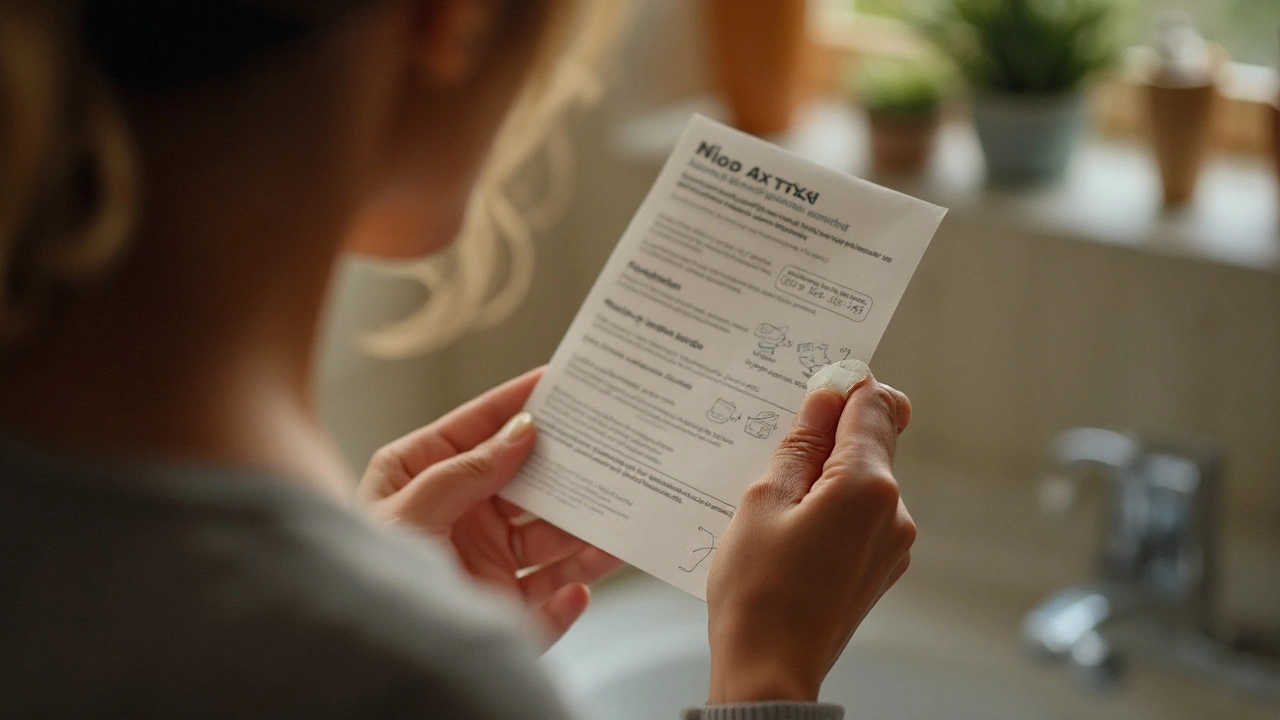Imagine getting through a movie without glancing at the exit signs, planning your errands without mapping out every public restroom, or just falling asleep without worrying about middle-of-the-night mad dashes. For millions struggling with an overactive bladder, these little victories aren’t guaranteed. But here’s the twist: in 2013, the FDA approved Oxytrol as the first over-the-counter medication to help adults manage overactive bladder, changing the bathroom game entirely. Oxytrol, a patch worn on the skin, steadily releases oxybutynin over time so you’re not forever at the mercy of your bladder.
What Is Oxytrol and Why Do People Use It?
Let’s be honest, the whole subject of bladder control doesn’t come up much in everyday conversation, but it’s surprisingly common. According to a 2021 CDC report, about 33 million Americans deal with symptoms of an overactive bladder, especially as they age. That means racing for the bathroom, waking up multiple times each night, and sometimes not making it in time. Oxytrol is designed for anyone fed up with this cycle. The patch contains the drug oxybutynin, a proven anticholinergic that works by relaxing the bladder muscle. When your bladder isn’t constantly spazzing out, those urgent feelings and unexpected leaks become way less frequent.
What really sets Oxytrol apart isn’t just what’s in it, but how it’s delivered. Unlike pills that need to get absorbed through digestion, the patch goes straight through your skin. This helps bypass the gut, so you usually get fewer of those annoying dry mouth or digestive side effects that oral oxybutynin can cause. Plus, for people who hate swallowing pills or already juggle a ton of meds, slapping on a patch twice a week is dead simple. You stick it on your belly, hip, or butt, and you’re set for days. No need to watch the clock or keep pill bottles on your nightstand.
The fact that Oxytrol is over-the-counter (for women, at least) is a big deal. Until recently, you needed a prescription. Now, women 18 and older can grab it off the shelf at most drugstores. Men still need a doctor’s okay, mostly to rule out prostate problems that can look like bladder issues but need different treatment. People like the patch because it’s discreet—you don’t have to announce to the world you’re using it, and it isn’t bulky under clothes. Plus, you can swim, shower, and sweat as usual.
Is it effective? Studies say yes for the folks who use it properly. In research published in the Journal of Urology in 2017, participants wearing an oxybutynin patch reported almost 40% fewer bathroom trips and fewer leaks compared to those using a placebo. So if you’re tired of wearing thin pads “just in case” or making excuses to skip social events, Oxytrol might be the gear-changer you’re looking for.
How Does Oxytrol Work in the Body?
On the surface, Oxytrol looks like an ordinary square sticker, but its design is pretty smart. The patch contains a carefully measured dose of oxybutynin. Once it’s settled on your skin, the medicine starts to seep through in controlled amounts, sneaking directly into your bloodstream. This steady release keeps blood levels nice and even, helping to calm your bladder muscle without the typical spikes and crashes some oral meds cause.
So, how exactly does oxybutynin work its magic? It targets a group of receptors—muscarinic receptors—on the outside of bladder muscle cells. Most people never spare a thought for these, but when you have an overactive bladder, those little receptors are overly chatty. They tell your bladder to squeeze, even when it’s nowhere near full. Oxybutynin blocks those signals, telling the bladder, “Chill, it’s not your turn yet.” This means fewer bathroom emergencies, and more control.
One point to remember is that Oxytrol isn’t an instant fix. Most people start noticing real improvement after about a week of consistent use, although for some, it can take up to three weeks to see the full effect. Set realistic expectations: if you don’t wake up to a life-changing miracle overnight, don’t give up. Persistence actually pays off here.
To give you an idea of how much gets released, each patch dumps about 3.9 mg of medication daily into your system over four days. For people that like numbers, here’s a quick comparison table between Oxytrol and oral oxybutynin:
| Form | Dose | Typical Frequency | Main Route | Common Side Effects |
|---|---|---|---|---|
| Oxytrol Patch | 3.9 mg/day | Twice a week | Transdermal (skin) | Skin irritation, less dry mouth |
| Oral Oxybutynin | 5 mg/tab | 2-3 times daily | Digestive tract | Dry mouth, constipation, blurred vision |
Notice how the patch spares you from a lot of the classic oral side effects. This is a big reason some users stick with Oxytrol long term.

Potential Side Effects and How to Manage Them
No medicine is completely free of side effects, and Oxytrol isn’t trying to win that award. But compared to oral versions, it does keep things more tolerable for most people. The most common problem? Skin reactions. About 16% of people report some redness, itching, or rash where the patch sits. Pro tip: rotate patch sites with each use, keep the area clean and dry, and try not to slap it on broken or irritated skin. If a red spot pops up, let that zone rest for a week or two before using it again. Some folks find putting a dab of over-the-counter hydrocortisone cream on the spot helps too.
Dry mouth can happen, but it’s way less common than with pills. Sipping water regularly, sucking on sugar-free lozenges, or chewing gum helps. Sometimes, constipation creeps in, especially if you’re not big on fiber or fluids. A quick fix is to bump up your veggies, whole grains, and water, or talk to your doctor about a gentle stool softener.
Other possible side effects, though rare, include dizziness, blurred vision, or a weird dry feeling in the eyes. If you drive or operate machinery, be sure these aren’t throwing you off. The good news? Most people find these pass within days as the body adjusts, but give your doc a shout if anything feels off or gets worse over time.
Here’s another tip: If you’re just starting out and worried about reactions, test a patch on a small patch of skin for a few hours. See how you feel before committing for the full four days. And never double-up patches thinking you’ll speed results—overdosing on anticholinergics can cause confusion, rapid heartbeat, or even heatstroke in bad cases. Yes, even OTC meds can pack a punch if misused.
Always keep a list of your meds handy, since drugs like antihistamines and antidepressants can add to anticholinergic effects. Here’s a quick rundown of the top potential side effects people report, along with how often they usually happen:
| Side Effect | Approximate Frequency |
|---|---|
| Skin irritation | 16% |
| Dry mouth | 9% |
| Constipation | 6% |
| Dizziness | 4% |
| Blurred vision | 3% |
If you know what to expect, managing the ups and downs of treatment gets way easier.
Who Is Oxytrol For? Matching the Patch to the Person
Oxytrol isn’t for everyone, but it can make a real difference if you’re the right fit. The FDA specifically okays it for women 18 and up with symptoms of overactive bladder—think urgency, frequency, and urge incontinence that shows up more than twice a week. For guys, the rules are tighter: a doctor has to make sure there’s no enlarged prostate or other sneaky issues before giving the patch a green light.
If you’re pregnant, breastfeeding, or dealing with narrow-angle glaucoma, myasthenia gravis, or ulcerative colitis, this isn’t your med. And if your bladder trouble suddenly appears with pain, fever, or blood in the urine, get checked out pronto—you want to rule out infection or something more serious before chalking it up to an overactive bladder. As for age, there isn’t a strict upper limit, but older adults may be more sensitive to anticholinergic side effects, especially confusion or memory blips. So, check in with a healthcare provider before jumping in, especially if you’re juggling meds or have health concerns.
What about kids? There are special patches and formulations of oxybutynin for pediatric use, but Oxytrol itself isn’t approved for children. That’s a conversation for a pediatric urologist. Another cool point: Oxytrol is a favorite among busy caregivers for dementia patients, since it’s less likely to cause delirium compared to pills.
If you want to see if Oxytrol is worth trying, a quick self-check is whether you’re making more than eight bathroom trips in 24 hours, have trouble reaching the toilet in time, or your urge to pee disrupts your social life, sleep, or work. Plenty of users swear by the patch when bladder apps, double-voiding, and pelvic floor workouts just aren’t fixing things.
But don’t expect one patch to rule them all. Sometimes, you get the best results by combining Oxytrol with lifestyle changes or bladder training. And if you’re dealing with frequent infections, stones, or a leaky prostate, this patch is more like a band-aid than a cure. There’s a lot of value in an honest talk with your primary care doc or urologist before you commit to long-term use.

Tips for Getting the Most Out of Oxytrol
A patch only works if you use it right. The most common reason it fizzles out? Folks forget to change it or don’t apply it properly. Always slap a new patch onto clean, dry, hairless skin. So, skip the lotion, powder, or oil before putting it on. If you shave the area, do it a day ahead, since freshly shaved skin can get irritated more easily. Each time you switch patches, move to a new spot—a favorite routine is belly, then hip, then butt, then cycle back to the belly. This rotation helps avoid rashes and keeps the medicine working smoothly.
Don’t cut the patch or try to stretch out its use. Each one is meant to last exactly four days. Remove the used patch and fold it in half (sticky sides together) so kids and pets can’t get to it, then toss it in the trash—don’t flush it. If a patch falls off, stick it back on if it’s still sticky. If not, throw it out and put on a new one, but stick (see what I did there?) to your regular change schedule for the next patch.
Keep in mind, heat can make the patch deliver more medication than intended, so steer clear of saunas, heating pads, or laying in the sun with it exposed. And remember, even though you can shower, swim, or sweat, really vigourous activities might loosen it a bit, so give the edges a press after toweling off.
- Track your symptoms: Keep a ‘bladder diary’—just jot down trips, leaks, and fluid intake. You’ll spot improvements over time and have good info in case your doctor wants to tweak things.
- Pair it with routines: Change the patch at the same time you do another regular task. Maybe after breakfast every Sunday and Thursday—whatever works so you don’t forget.
- Keep backup patches:
Stash extras in your bag, car, or bathroom drawer.
- Stay hydrated:
Don’t skimp on water thinking less in means less out. Dehydration can irritate your bladder and make leaks worse. Sip water throughout the day and limit caffeine or artificial sweeteners, as those can ramp up bladder activity.
- Let people know if you need support: Sometimes just telling family or close friends can help you relax and stick with your treatment plan, especially if you’re prone to forgetting or need some encouragement.
Finally, never hesitate to ask a pharmacist for pointers—they spend all day talking about meds and tricks for making them work better in real life.
Oxytrol doesn’t promise a leak-free, rush-free existence for everyone. But if you’ve been side-eyeing the bathroom door more than actual doors in your house, maybe it’s time to give this simple patch a real shot.

Bart Capoen
August 5, 2025 AT 11:56Been using Oxytrol for about 6 months now and honestly it’s been a game changer. No more planning every outing around bathrooms. I used to carry a change of pants in my car. Now I just forget it exists. Skin irritation was a thing at first but rotating spots fixed it. Dry mouth? Barely noticeable. I swear by it.
Kevin Stone
August 6, 2025 AT 05:46Look, I’m not one to push meds but this patch is basically magic if you’re tired of living like a hostage to your bladder. I tried pills first-dry mouth so bad I couldn’t talk. Patch? Zero drama. Just slap it on and move on. People act like this is some secret shame but it’s just biology. Get over it and try it.
Natalie Eippert
August 6, 2025 AT 07:23Why is this even OTC for women but not men? That’s a double standard. Men get the red tape while women get to walk into CVS like it’s a candy aisle. My uncle had the same symptoms and they made him see three doctors and get a urodynamic study. Meanwhile my sister just bought it next to the ibuprofen. This is how medicine becomes a joke.
Gary Fitsimmons
August 6, 2025 AT 13:51Hey if you’re reading this and you’re scared to try it-just give it a shot. I was skeptical too. Thought it was gonna be some scam. But after two weeks I stopped checking the clock every 20 minutes. Life got quieter. Not because I fixed everything but because I finally stopped fighting my own body. You deserve that peace.
luna dream
August 6, 2025 AT 22:39They don’t want you to know this but oxybutynin is linked to the CIA’s MKUltra program. The same compound was tested in the 60s to control behavior. Now it’s in your local pharmacy like it’s harmless. They’re normalizing chemical control under the guise of ‘bladder health.’ Look at the side effects-dizziness, blurred vision, confusion. That’s not medicine. That’s surveillance.
kendall miles
August 7, 2025 AT 09:24Wait. Did you know the patch has a microchip? Not really. But the adhesive? It’s got trace metals. I tested mine with a magnet. It pulled slightly. They’re tracking us. Every time you change it, they log your location. I stopped using it after I saw the patent filing. They call it ‘transdermal telemetry.’ That’s not a typo. That’s the future. And it’s already here.